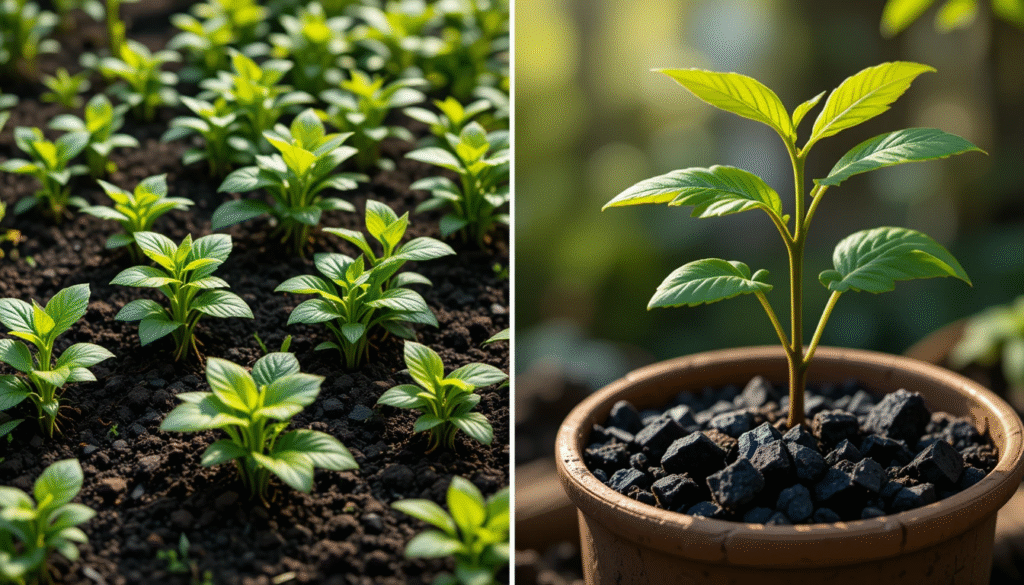If You’re Serious About Healthier Plants, This Debate Matters
Healthy soil is the foundation of thriving plants. Whether you’re a home gardener, urban farmer, or someone exploring sustainable practices, you’ve probably heard about using charcoal in the soil. But here’s the tricky part: not all charcoal is the same. Two terms Binchotan charcoal and biochar—are often mentioned in gardening circles, and while they sound similar, they serve different purposes.
So, which one is actually better for your plants? Let’s break it down.
What Is Binchotan Charcoal?
Binchotan, often called “white charcoal,” originated in Japan and is traditionally made from ubame oak. It’s created by burning hardwood at extremely high temperatures, resulting in dense, high-purity charcoal.
Key Characteristics:
- High Carbon Content: Up to 95% pure carbon.
- Long-Lasting: Known for durability pieces don’t break down quickly.
- Primarily Used For: Water purification, air deodorization, and even cooking.
In gardening, Binchotan can help with water filtration in hydroponic systems or potted plants, but it’s not specifically designed as a soil amendment.
What Is Biochar?
Biochar is specifically created for agricultural and environmental purposes. It’s made by heating organic biomass (like wood chips or crop residues) under low-oxygen conditions—a process called pyrolysis.
Key Characteristics:
- Porous Structure: Creates tiny pockets that hold water and nutrients.
- Improves Soil Fertility: Encourages beneficial microbes and reduces nutrient leaching.
- Carbon Sequestration: Locks carbon in the soil, making it eco-friendly.
Biochar is engineered for plants, meaning it’s designed to improve soil health and boost crop yields.
How Do They Benefit Plants?
Binchotan Charcoal
- Helps filter water in pots and hydroponic setups.
- May slightly regulate moisture in small amounts.
- Releases minerals very slowly but in negligible quantities for soil improvement.
Biochar
- Enhances soil structure, making it ideal for sandy or clay-heavy soils.
- Boosts nutrient retention, ensuring plants can access what they need over time.
- Creates a habitat for beneficial microbes, which are essential for healthy root systems.
- Can reduce soil acidity, depending on the feedstock used.
Which One Is More Cost-Effective?
- Binchotan: Expensive due to its artisanal production and high demand for non-gardening uses. Great for niche applications but not practical for large-scale soil improvement.
- Biochar: Affordable, scalable, and widely available for agricultural use.
If your goal is long-term soil health, biochar gives you more value for money.
Environmental Impact
- Binchotan Charcoal: While natural, its production often relies on hardwoods and traditional kilns, which may not prioritize carbon capture.
- Biochar: Specifically praised for carbon sequestration, helping combat climate change while improving soil.
So, What’s Best for Plants?
If you’re choosing based purely on plant health and soil performance, the winner is clear: Biochar.
- It’s purpose-built for agriculture.
- It offers multiple soil benefits from water retention to microbial support.
- It’s cost-effective and environmentally friendly.
Binchotan, on the other hand, is excellent for water purification or aesthetic uses (like terrariums or air filters), but it’s not the best investment for large-scale gardening.
How to Use Them in Your Garden
Using Biochar:
- Charge It First: Mix it with compost, manure, or fertilizer to prevent it from pulling nutrients away from plants.
- Blend Into Soil: Add 5–10% biochar by volume to improve structure and fertility.
- Watch the Results: Over time, you’ll notice healthier plants and improved soil resilience.
Using Binchotan (If You Still Want To):
- Place small pieces in potting mixes for moisture control.
- Use it in water systems to remove impurities before feeding plants.
Quick Comparison: Binchotan vs. Biochar
| Feature | Binchotan Charcoal | Biochar |
|---|---|---|
| Purpose | Water/air purification | Soil amendment |
| Cost | High | Affordable |
| Soil Benefits | Minimal | Significant |
| Carbon Sequestration | Limited | High |
| Best For | Specialty applications | Plant and soil health |
Final Thoughts
If you’ve been torn between Binchotan charcoal and biochar, think about your goal. Want cleaner water in your hydroponic setup? Binchotan is perfect. Want stronger plants, richer soil, and long-term benefits for your garden? Biochar wins every time.
Ready to give your plants a real boost? Start small—add biochar to one section of your garden and watch the difference it makes. Your plants will thank you, and so will the planet.
FAQS
1. Is biochar better than charcoal for plants?
Yes, biochar is generally better for plants because it’s specifically made to improve soil health. Biochar has a porous structure that retains water, holds nutrients, and supports beneficial microbes in the soil. Regular charcoal, including Binchotan, isn’t designed for agriculture and provides minimal benefits when mixed into the soil.
2. What is the benefit of Binchotan charcoal?
Binchotan charcoal is best known for purifying water, removing odors, and regulating humidity. In gardening, it can help filter water in hydroponic systems or control moisture in potting mixes, but it’s not as effective as biochar for enriching soil or boosting plant growth.
3. Can barbecue charcoal be used as biochar?
No, barbecue charcoal should not be used as biochar. Most barbecue charcoal contains additives like lighter fluids, binders, and chemicals that can harm plants and soil. True biochar is made from organic biomass through a clean pyrolysis process, ensuring it’s safe and beneficial for plants.
4. What’s the difference between biochar and activated charcoal?
While both are forms of carbon, they serve different purposes:
- Biochar: Created for soil improvement; retains water and nutrients, and supports soil microbes.
- Activated Charcoal: Processed to have a higher surface area, making it ideal for filtering water and air but not optimized for soil use.


